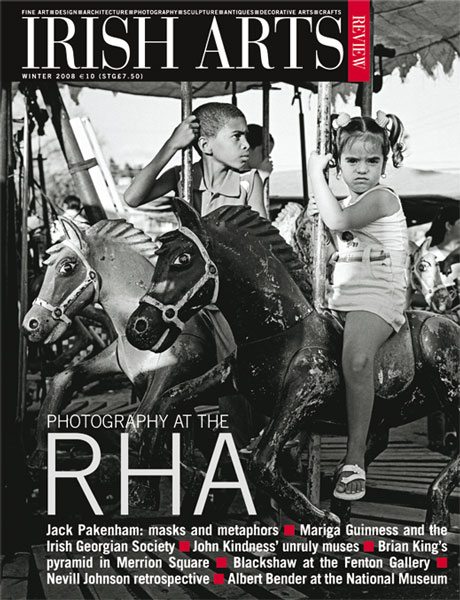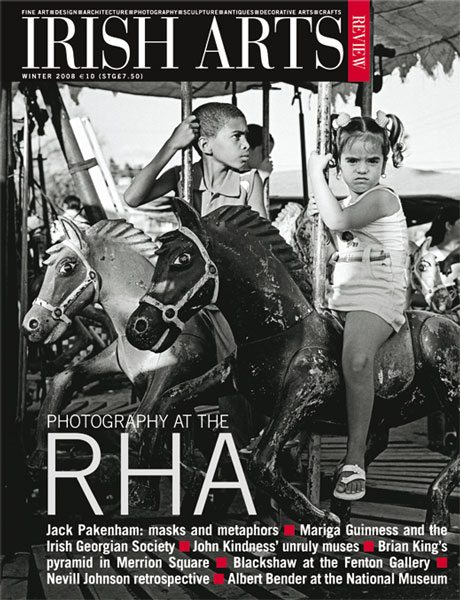

The exhibition mentioned below took place in Fenton Gallery, Cork in winter 2008, when this article was first published.
Riann Coulter finds a personal compendium collated with daring and vigour, in Basil Blackshaw’s work.
Have you ever seen a zebra in Co Antrim? There may be some in Belfast Zoo but, bar the possibility of a break out, I can’t imagine those distinctive stripes mingling with the cows in rural Ulster. Yet, just such a creature takes centre stage in Basil Blackshaw’s current exhibition at the Fenton Gallery, Cork. A painter known for both his connections to his local environment and his images of dogs and horses, captured with a breeder’s eye for form and temperament, Blackshaw has once again exercised his capacity to surprise and delight his devoted following by producing a new body of fresh and innovative work.
Expressively painted on a parchment coloured ground, Zebra (Fig 3) resembles an elaborate graffito scratched into a plastered wall. The text – mostly illegible – that litters the canvas and the uneven border glimpsed beneath the chalky paint enhances the sense that this image has been hastily executed directly onto a crumbling facade. Blackshaw’s enthusiasm for graffiti is well documented. As he told Brian McAvera in 2005, ‘I love graffiti on walls, get more inspiration from that than anything else!’. As the recent fame of artists such as Banksy suggests, Blackshaw is not alone in his appreciation for graffiti. But as the audience for street art is drawn from a relatively young demographic, this seventy-six-year-old artist is certainly amongst its more senior fans.
While the large mixed media work, Wall, included in Blackshaw’s 2005 exhibition at the Fenton Gallery, displayed the inspiration of graffiti in an almost unmediated form, Zebra and most of the other paintings in the current show suggest a more mongrel heritage that unites graffiti with the expressive scribbles of child art, the obsessive mark making associated with Outsider Art and elements of Art Autre, particularly the work of Fautrier and Dubuffet.
A countryman born and bred, Blackshaw has a native’s respect for nature.
Despite this international inspiration, the origins of these works do not represent a complete departure from Blackshaw’s more familiar rural themes. Like his fellow Ulsterman, Colin Middleton, Blackshaw is adept at bringing outside influences to bear on his experiences of the particular. For over half a century the landscape and inhabitants of rural Antrim and Down have fuelled his artistic imagination and his reputation was made with art that displayed deep connections to his native place. While this recent body of work appears to depart from those rural themes, the initial inspiration for many of these works can be traced to a child’s nature study jotter rescued from a puddle while walking down a country lane.
The traces of this source are most obvious in the large work Page. While the scale suggests another graffitied wall, this piece is constructed from two canvases placed together creating the sense of an open jotter filled with scribbled notes and rough sketches of stringy wild flowers. Collaged elements, including pieces of masking tape stuck at intervals along the top of the canvas, add to the illusion that we are reading a dog-eared scrapbook. Closer examination of the textured surface reveals particles of grit and sand mixed in with the paint. Pencil, charcoal and chalk blend with the washes of ochre and white pigment. What initially appears as quite a bare canvas is actually a densely worked surface constructed from layers of colour, texture and influence.
Two Butterfly Shapes (Fig 5) continues the theme of the painted page. Are we to read these ‘shapes’ as dead insects stuck into a collector’s album or a child’s drawings of the real thing? A numbered scale, roughly sketched along the vertical edge of the canvas introduces both the idea of scientific study and an element of order to the composition. Relating to Blackshaw’s earlier works Self-Heal and Bird’s-foot from 2005, which were also inspired by the found nature journal, Two Butterfly Shapes suggests the act of recording things precious and rare. A countryman born and bred, Blackshaw has a native’s respect for nature. He has expressed his anger at the greed and corruption which leads to the destruction of the natural environment, and these paintings, with their ochre patina of age, appear as both records of, and homages to, a disappearing world.
The exhibition also includes two figurative works. Although they initially appear to be a diversion from the main theme, they too use the motif of the painted page and can be seen in terms of preservation. Couple (Fig 2) features a blurred image of a man and woman in Edwardian dress. The image evokes an old sepia-tinted photograph, torn at the edges and slightly out of focus, which has been stuck into an album to keep it safe. One of the few works without text, there are no clues as to the identity of these people. Is this a found image or one handed down through the generations? In truth, it doesn’t matter because Blackshaw’s subject is not the individuals depicted but rather this photographic relic of their existence. The other figurative work, a seated nude, is an image familiar from earlier paintings such as Seated Figure, 2000. Here, Blackshaw’s painted page is a sheet from his own sketch book, complete with redundant bits of tape to fix it in place and preserve it for posterity.
Perhaps the overarching theme of this show is representation. Texts, drawings, photographs and paintings are represented on pages painted onto canvas. Collaged elements and the use of several different media, confuse matters further. What we are left with are layers of representation built one upon the other. Considered in this context the whole exhibition can be seen as a scrapbook. Each work a page, both complete in itself and contributing to the larger whole. The result is a compendium of Blackshaw’s current influences and ideas and a true testament to the continuing vitality and courage of this remarkable artist.
Riann Coulter is an art historian.
All images ©The Artist.
1 Blackshaw to Brian McAvera, ‘Basil Blackshaw: A New Vision’, Irish Arts Review, Winter 2002, vol. 19, no. 3.
2 Eamonn Maile, ‘A Studio Visit’, Basil Blackshaw, Fenton Gallery 2005, p. 29.
3 Blackshaw to McAvera, Irish Arts Review, 2002.
From the IAR Archive
First published in the Irish Arts Review Vol 25, No 4, 2008



